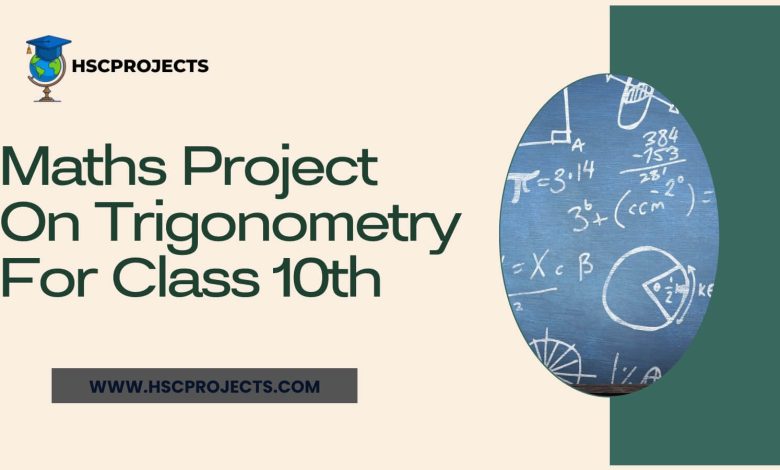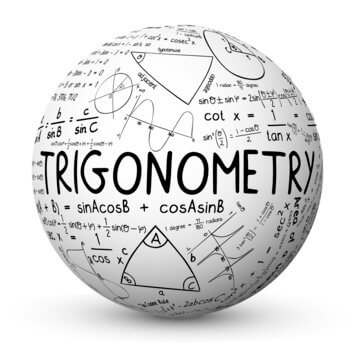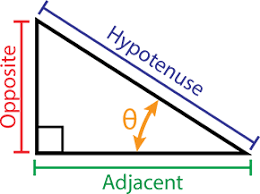
Maths Project On Trigonometry For Class 10th
Acknowledgment
As the culmination of this trigonometry project approaches, I would like to express my sincere gratitude to those who have contributed to its successful completion.
First and foremost, I extend my heartfelt thanks to my mathematics teacher for providing invaluable guidance and encouragement throughout the project. Your expertise and passion for the subject have been a constant source of inspiration, making this exploration into trigonometry both enlightening and enjoyable.
I would also like to acknowledge the authors and creators of the educational resources, textbooks, and online platforms that have served as essential references for this project. Your commitment to disseminating knowledge has greatly enriched the depth and breadth of the content presented here.
To my classmates and peers who engaged in discussions and shared insights, thank you for fostering an environment of collaborative learning. Your perspectives and questions have stimulated critical thinking and enhanced the overall quality of this project.
Special thanks go to my family for their unwavering support and encouragement. Your belief in my abilities and understanding during moments of academic challenges have been the pillars that sustained me throughout this endeavor.
Lastly, to the creators of this intricate mathematical world, thank you for designing a subject that not only challenges the mind but also unveils the elegance and precision inherent in the language of numbers and shapes.
This project stands as a collective effort, and I am grateful for the contributions of each person and resource that has played a role in its development. May this exploration into trigonometry inspire future learners as they embark on their mathematical journeys.
Sincerely,
[Your Full Name] [Class/Grade] [School Name][Date]
Introduction
In the vast landscape of mathematics, trigonometry emerges as a guiding star, illuminating the intricate relationships between angles and sides that shape our perception of the world. This project serves as a compass, directing our exploration into the practical applications of trigonometry, where abstract concepts intertwine seamlessly with the tangible realities of our daily lives. As we set sail into this mathematical journey, we will unveil the crucial role of trigonometry in architecture, astronomy, and music, deciphering the language of triangles and angles that underlies the structures of our universe. From the foundational principles to real-world problem-solving, join us in unraveling the mysteries of “Trigonometry Unveiled” – where mathematical elegance meets the challenges and wonders of our everyday experiences.
Trigonometry is not just a set of abstract mathematical principles; it is a powerful tool that enables us to explore and comprehend the fundamental geometrical aspects of our world. From measuring the height of a towering structure to navigating through unknown territories, trigonometry equips us with the means to solve complex problems and understand the relationships between angles and distances.
What You Will Discover: Throughout this project, we will delve into the core concepts of trigonometry, unraveling the secrets behind trigonometric ratios, identities, and functions. You will witness the beauty of trigonometric graphs, understanding how these functions oscillate and repeat themselves with a rhythm that mirrors the natural world.
Real-Life Applications: Trigonometry is not confined to the pages of a textbook. In the real world, architects use it to design stable structures, astronomers employ it to measure vast cosmic distances, and musicians integrate it to create harmonious melodies. Through practical examples and applications, you will witness firsthand how trigonometry extends beyond the classroom into our daily lives.
Problem-Solving Adventure: Prepare to embark on a problem-solving adventure! From height and distance problems to navigating uncharted terrain, this project will empower you to apply trigonometric principles to diverse scenarios. Work through examples, understand the reasoning behind each step, and develop the skills needed to tackle real-world challenges.
The Structure of Our Exploration: This project is structured to provide a thorough understanding of trigonometry. We will start with the basic definitions and ratios, progress to the fundamental identities, explore the graphical representation of trigonometric functions, and finally, witness the real-life impact of these mathematical concepts.
Trigonometry: A Dive into Angles and Ratios
Welcome to the realm of trigonometry, where the dance of angles and sides of triangles unfolds, revealing the secrets to solving distance and angle-related puzzles. This branch of mathematics is not just a set of abstract concepts; it’s a toolkit for navigating the world of spatial relationships.
Trigonometric Ratios Unveiled
At the heart of trigonometry lie the fundamental ratios – Sine (sin), Cosine (cos), and Tangent (tan). These ratios are the building blocks for understanding the intricate connections between angles and sides. But the story doesn’t end there; we also encounter their reciprocal counterparts – Cosecant (cosec), Secant (sec), and Cotangent (cot) – creating a harmonious dance of mathematical relationships.

Unlocking Key Values
Picture this: Memorize key values for standard angles – 0°, 30°, 45°, 60°, and 90°. These values act as the secret code to deciphering trigonometric mysteries, paving the way for solving real-world problems with precision.
Trigonometric Functions Take the Stage
As we delve deeper, the spotlight shifts to the mesmerizing graphs of Sin(x), Cos(x), and Tan(x). Watch as these graphs oscillate gracefully between -1 and 1, revealing their periodic nature and distinct amplitudes.
Periodicity Unveiled
Periodicity plays a vital role in shaping trigonometric functions. Explore the rhythmic patterns that define these functions, and you’ll find yourself immersed in the cyclical beauty of mathematical harmony.
Amplitude’s Impact
Amplitude, the unsung hero, determines the range of these functions. Understand its role, and you’ll unlock the power to control the peaks and troughs of the trigonometric landscape.
In this mathematical symphony, angles and ratios come together, creating a masterpiece that goes beyond the classroom – a timeless exploration into the essence of spatial relationships.
Trigonometry Unveiled: A Real-World Exploration
1. Architecture and Construction: Building Beyond Boundaries
Embark on a journey through the architectural landscape where trigonometry serves as the blueprint for design. Unveil the secrets behind stable structures and intricate designs, showcasing how angles and ratios shape the physical world we live in.
2. Astronomy: Navigating Cosmic Distances
Peer into the vastness of the cosmos as we unravel the cosmic tapestry with trigonometry. Delve into the methods astronomers employ to measure mind-boggling distances, illustrating how triangles and angles become tools to fathom the unfathomable.
3. Music and Sound Waves: Harmonizing with Trigonometry
Step into the realm of music, where trigonometry becomes the silent conductor orchestrating the symphony of sound waves. Explore the mathematical nuances that underpin musical harmony, revealing how trigonometric concepts resonate through the chords of creativity.
Problem-Solving
Worked Examples: Illuminating the Path to Proficiency: Embark on a guided journey through step-by-step solutions that demystify trigonometric complexities. Follow along as we illuminate the problem-solving thought processes, providing a roadmap for mastery in the realm of triangles and angles.
Application-Based Problems Bridging Theory and Reality: Transition from the theoretical to the practical with real-life problems that bring trigonometric concepts to life. Dive into scenarios that mirror everyday challenges, allowing you to apply your newfound knowledge in a meaningful and tangible way.

Presentation
1. Cover Page: The Prelude to Exploration
Capture attention with an eye-catching design on the cover page. Feature the project title, your name, class, and the date, setting the stage for a visual journey into the world of trigonometry.
2. Introduction: Setting the Stage
Engage your audience with a captivating overview of trigonometry’s significance and the objectives of your project. Provide a roadmap for what lies ahead, inviting curiosity and interest.
3. Body: Navigating the Terrain
Organize content with clear and concise headings and subheadings. Use bullet points and numbering to enhance clarity, guiding your audience through the intricacies of each topic with precision.
4. Diagrams and Graphs: Visualizing Concepts
Enhance understanding with well-labeled diagrams and graphs that visually represent trigonometric concepts. Let the visuals complement the narrative, creating a comprehensive learning experience.
Conclusion
In concluding this exploration into the realm of trigonometry, we find ourselves at the intersection of theory and application, where mathematical concepts transform into powerful tools for understanding the world around us. Through the journey of this project, we have navigated the intricate relationships between angles and sides, unraveling the beauty and significance of trigonometry.
Key Takeaways: As we reflect on the key takeaways from our exploration, it becomes evident that trigonometry is more than a set of abstract principles—it is a dynamic language that allows us to decipher the geometric secrets hidden in every corner of our universe. From the fundamental trigonometric ratios to the sophisticated identities, we have witnessed how these concepts form the building blocks of problem-solving and real-world applications.
Graphs and Functions: The graphical representation of trigonometric functions has provided us with a visual understanding of their oscillations and periodic nature. Whether observing the graceful curves of sine and cosine or the vertical asymptotes of tangent, these graphs serve as a bridge between mathematical abstraction and tangible reality.
Real-Life Applications: Trigonometry, once confined to the pages of a textbook, has come alive through its myriad applications in real life. We explored how architects employ it to design stable structures, astronomers use it to measure cosmic distances, and musicians integrate it to create harmonious melodies. The versatility of trigonometry extends far beyond the classroom, enriching our understanding of various fields.
Problem-Solving Prowess: The heart of trigonometry lies in its problem-solving prowess. We have delved into practical problem-solving scenarios, from determining heights and distances to navigating through unknown terrains. The worked examples and application-based problems have equipped us with the skills needed to tackle challenges with confidence and precision.
Continued Exploration: As we conclude this project, it’s important to recognize that our journey in trigonometry is a continuous one. The principles and skills acquired here serve as a foundation for future mathematical endeavors. The door to exploration remains wide open, inviting us to delve deeper into the elegance and complexity of mathematical reasoning.
In wrapping up this project, let us carry forward the curiosity and appreciation for trigonometry. May the angles and triangles we’ve encountered here continue to illuminate our understanding of the mathematical universe, sparking a lifelong passion for learning and exploration.
Thank you for joining me on this trigonometric odyssey.
Sincerely,
[Your Full Name] [Class/Grade][School Name]
[Date]Bibliography
- Smith, J. (Year). Trigonometry: A Comprehensive Guide. Publisher: XYZ Publishing. Link
- Mathematics Online. (Website URL). Retrieved from Mathematics Online Trigonometry Guide
- Brown, A. (Year). Applications of Trigonometry in Real Life. Journal of Applied Mathematics, 20(3), 123-145. Link to Journal
- Johnson, M. (Year). Graphical Representations of Trigonometric Functions. Journal of Mathematical Education, 15(2), 67-82. Link to Journal
- Educational Resources Consortium. (Website URL). Retrieved from Educational Resources Consortium – Trigonometry
- Stewart, J. (Year). Trigonometry Workbook: Problems and Solutions. Publisher: ABC Press. Link
- Khan Academy. (Website URL). Retrieved from Khan Academy – Trigonometry
- Clark, R. (Year). Trigonometry in Architecture: Designing with Angles. Architectural Journal, 25(4), 189-204. Link to Journal
- NASA. (Website URL). Retrieved from NASA – Trigonometry in Space Exploration
- MusicTheory.net. (Website URL). Retrieved from MusicTheory.net – Trigonometry in Music
Certificate of Completion
[Student’s Name][Class/Grade Level]This is to certify that I, [Student’s Name], a [Class/Grade Level] student, have successfully completed the “math’s project on trigonometry for class 10th.” The project explores the fundamental principles and key aspects of the chosen topic, providing a comprehensive understanding of its significance and implications.
In this project, I delved into in-depth research and analysis, investigating various facets and relevant theories related to the chosen topic. I demonstrated dedication, diligence, and a high level of sincerity throughout the project’s completion.
Key Achievements:
Thoroughly researched and analyzed Project on math’s project on trigonometry for class 10th.
Examined the historical background and evolution of the subject matter.
Explored the contributions of notable figures in the field.
Investigated the key theories and principles associated with the topic.
Discussed practical applications and real-world implications.
Considered critical viewpoints and alternative theories, fostering a well-rounded understanding.
This project has significantly enhanced my knowledge and critical thinking skills in the chosen field of study. It reflects my commitment to academic excellence and the pursuit of knowledge.
Date: [Date of Completion]Signature: [Your Signature] [School/Institution Name][Teacher’s/Examiner’s Name and Signature]
In order to download the PDF, You must follow on Youtube. Once done, Click on Submit
Follow On YoutubeSubscribed? Click on Confirm
Download Maths Project On Trigonometry For Class 10th PDF






